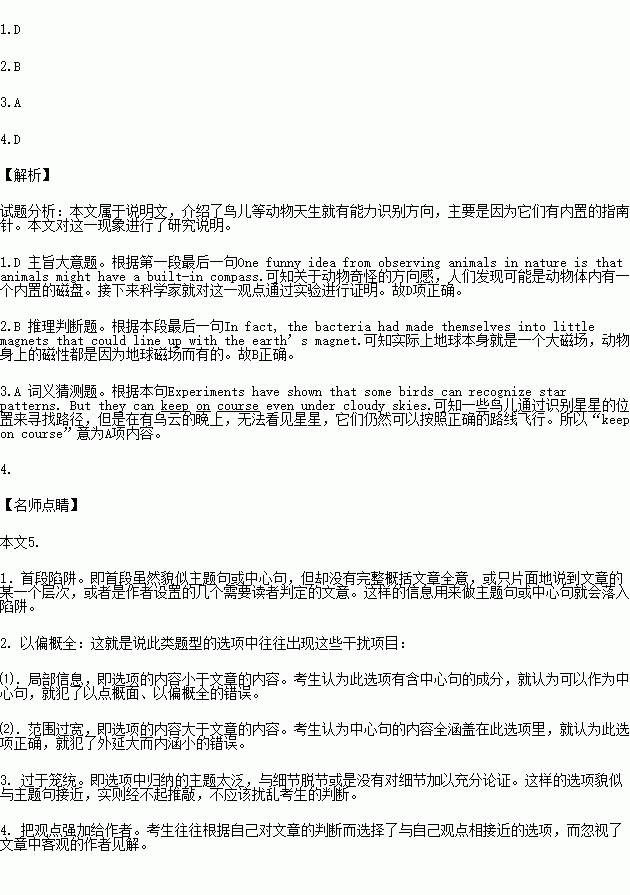题目内容
For more than twenty years scientists have been seeking to understand the mystery of the “sixth sense” of direction. By trying out ideas and solving problems one by one, they are now getting closer to one answer. One funny idea from observing animals in nature is that animals might have a built-in compass.
Many birds migrate(迁徙)twice a year between their summer homes and winter homes. Some of them fly for thousands of kilometers and mostly at night. Experiments have shown that some birds can recognize star patterns. But they can keep on course even under cloudy skies. How can they do that? A common bird that does not migrate but is great at finding its way home is the horning pigeon(鹤子)and they have been widely studied. One interesting experiment was to attach little magnets (磁铁,磁场)to the birds’ heads to block their magnetic sense — just as a loud radio can keep you from hearing a call to dinner. On sunny days, that did not fool the pigeons. Evidently they can use the sun to tell which way they are going. But on cloudy days, the pigeons with magnets could not find their way. It was as if the magnets had blocked their magnetic sense. Similar experiments with the same kind of results were done with honeybees.
In spite of the experiments, the idea of an animal compass seemed pretty extraordinary. How would animals get the magnetic stuff for a compass? An answer came from an unexpected source, A scientist was studying bacteria that lived in the mud of ponds. He found accidentally little rod-like bacteria that all swam together in one direction 一 north. In fact, the bacteria had made themselves into little magnets that could line up with the earth’s magnet.
The big news was that a living thing, even a simple bacterium,can make magnetite. That led to a search to see whether animals might have it. By using a special instrument, scientists were able to find magnetite in bees and birds,and even in fish. In each animal, except for the bee, the magnetic stuff was always in or close to the brain.
Thus, the idea of a built-in animal compass began to seem reasonable.
1.The main purpose of this passage is to .
A. explain how the animal compass was invented
B. answer how an animal would get the magnetic stuff for a compass
C .introduce a famous experiment
D. prove the idea that animals might have a built-in compass
2.Which of the following can we infer from Paragraph 3?
A. The bacteria magnetic sense seemed to be the same as the earth’s.
B. The earth itself is a big magnet with which something magnetic might lines up
C. Little rod-like bacteria were found to swim north together through experiments.
D. Migrant birds can easily lose their way because of lacking magnetie.
3.The underlined words “keep on course” in the second paragraph means“
A.stay in the correct flying route
B.lose one’s way
C.remain calm
D.recognize star patterns
4.Where is probably the built-in magnet for a fish according to the scientists?
A.Close to its stomach. B.In its heart.
C.Far from its brain. D.Inside its head.
 暑假作业暑假快乐练西安出版社系列答案
暑假作业暑假快乐练西安出版社系列答案
